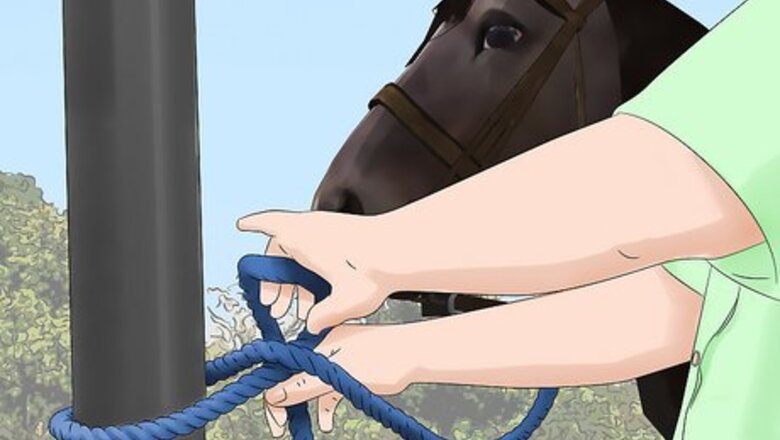
views
Setting Up for Success
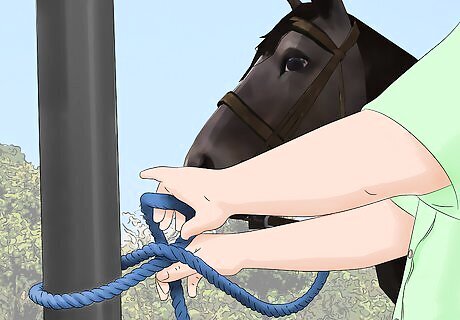
Tie up the horse. It is important to have a horse tied up while you are cleaning its hooves. This will ensure that it cannot bolt and that it is unable to move away from you. Tying up your horse before cleaning its hooves is a safety measure for both you and your horse. Tie up the horse using a quick release knot so that it can't move but you can untie it easily. If you're using cross ties, make sure they have quick-release snaps.

Gather your supplies. Keep all of your supplies within arm's reach when cleaning a horse's hooves. Having them nearby will allow you to do your work efficiently and will minimize your movements so that the horse doesn't get spooked. The tools you will need include: Work gloves Hoof pick Hoof brush Files or rasps for hoof trimming
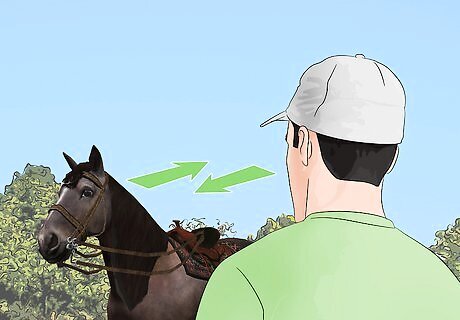
Approach the horse safely. When you are approaching a horse you should come towards it from the side so it can see you coming. It is important to allow a horse to see you coming so that it doesn't get spooked. Coming up behind a horse and touching it before it hears or sees you can cause it to kick or harm you out of fear. Instead, make your presence known by talking to the horse as you approach it. Start by scratching its neck and gradually work your way down its leg.
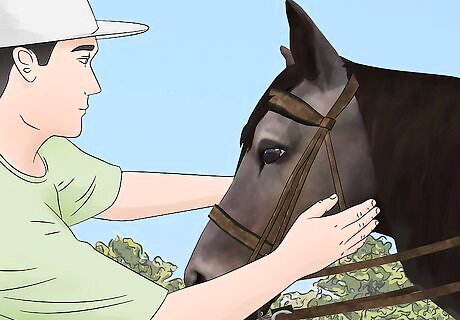
Make sure the horse is calm. A horse needs to trust you to let you handle its hooves, so take some time to treat it nicely before you start cleaning its hooves. Stroke its neck gently and speak to it so that it is aware you aren't going to hurt it. If you cannot get your horse to stay calm, you may need to get someone else to help you. Have them pet and calm the horse while you begin the cleaning process. If you have a horse that is anxious or untrained, it may take some time to get it comfortable enough with you to be able to clean its hooves.
Removing Debris From the Hoof
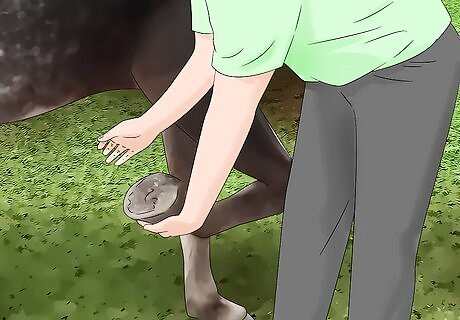
Position yourself next to the front hooves. Once you've approached the horse and it knows you are next to it, you should move so you are standing next to its shoulder. Face the horse's tail so you're protected if it tries to kick you. Then, gently squeeze the back of the horse's leg so it lifts its hoof and you can see the bottom of it. You can either hold the hoof with one hand and pick with the other or you can put the hoof between your thighs so that you have both hands free. This depends on what is most comfortable for you and your horse. Keep your feet together and pointed away from the horse. This will protect them a bit if the horse decides to put its foot down. As your horse gets used to the process, you can train it to lift its hoof for you when you get into position. This will make cleaning the hooves easier.
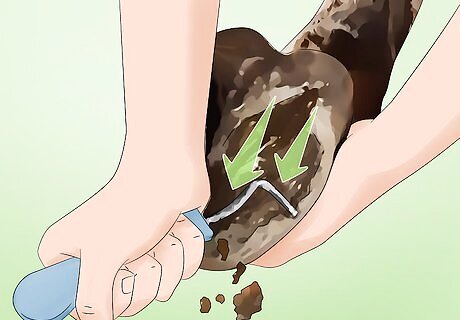
Use your pick to clean out large debris. Hold the pick so the hook is positioned below your hand. This will give you leverage on the pick so you can get it into the hoof. When cleaning the stones and muck out of the hoof you will need to use some force with the pick. However, you should only dig the point of the pick into the hoof really hard when you are trying to get a rock out. Don't be too forceful or dig too deep or you could damage the horse's hoof. If your horse is wearing shoes, make sure to clean away any debris that might be lodged between the sole of the hoof and the underside of the shoe.
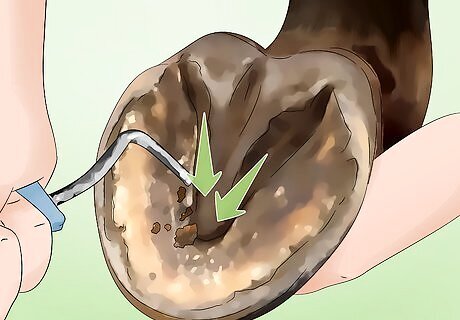
Move the pick down the sides of the frog. The frog is the inner part of the hoof that is shaped like a "v." You should run the point of the pick down the sides of the frog, from the back of the hoof to the front. This will clean out the area next to the frog and will loosen up any debris in the sole of the hoof, which is the sunken area in front of the frog. Make sure you are careful when cleaning the frog in particular. The hoof is pretty strong, so you'd have to pick pretty hard to injure it. However, you can hurt the horse if press the pick in really hard. Visualize how the inner part of the hoof is shaped so that you know what areas need to be cleaned out.
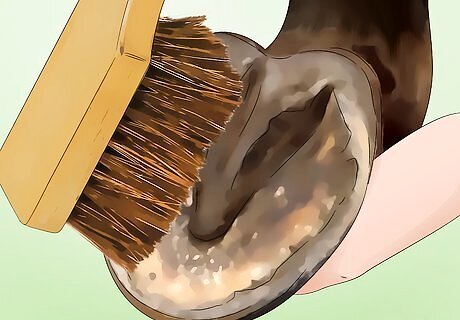
Remove smaller debris with a brush. Once you have removed all of the large debris from the hoof, you should use a stiff brush to get out any remaining small bits. Brushing out any remaining debris will allow you to really see the structure of the inner hoof and assess its health. When you are done removing debris you should be able to see all of the parts of the bottom of the hoof: the frog, the sole, and the outside wall of the hoof.
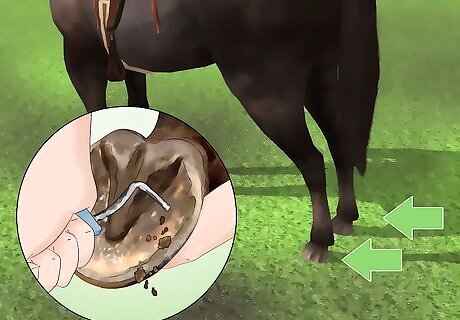
Repeat the process with the back hooves. Once you have finished both of the front hooves, you can re-position yourself to do the back hooves. Make sure that the horse is aware of your movements. Position yourself next to one of the horse's hips, still facing its rear end. Position the hoof between your thighs or in your hand again and clean out the hoof the same way as you did with the front hooves.
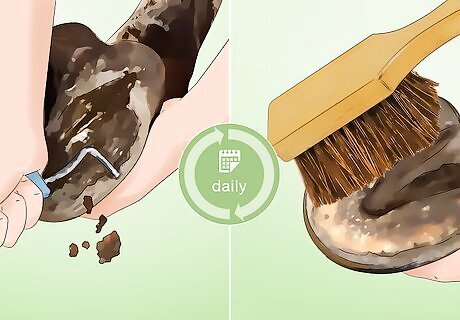
Clean out the horse's hooves daily. It is important to keep your horse's hooves clean and free of debris. Daily cleaning will ensure that the hooves stay healthy and that the horse can walk comfortably. Cleaning out the hooves is typically just one part of a daily grooming routine.
Inspecting the Horse's Hooves

Check the state of your horse's horseshoes. If your horse has horseshoes on, you should make sure that they are still secure. Check that all of the nails are in place and that the hooves have not been damaged by them. When a horseshoe is nailed on, it is nailed into the wall of the hoof. This can cause cracking if not done properly.

Inspect the hooves for cracks. Cracks are common in hooves that are dry, damaged, or overgrown. The cracks can be small and relatively harmless or they can be deep and cause the horse discomfort. Either way, they should be treated to ensure that the hoof does not become severely damaged and infected. Cracks should be treated so that they do not begin to cause the horse pain and negatively impact the animal's gait. Treatment will vary depending on the severity of the crack, so consult with a farrier or a veterinarian if you are unsure how to proceed. A farrier is a person who cares for horses' hooves professionally. If you catch the crack early enough, you should be able to easily repair it.
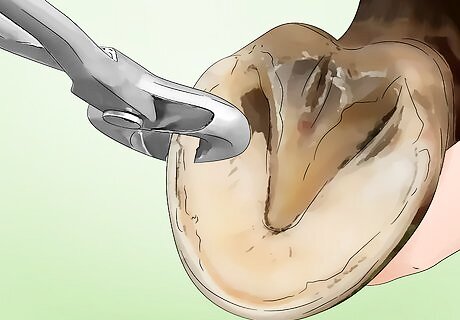
Decide whether the hooves need to be trimmed. If you do not work your horse a lot it may need its hooves trimmed. This is simply because its hooves have grown faster than the animal can wear them down. If the hoof is particularly long and overgrown, then it likely needs a trim. Typically horses need their hooves trimmed every 4-6 weeks. If you don't have any experience trimming horses' hooves then you might want to hire a farrier. Horses' hooves are very sensitive, so it's important you know what you're doing before you try to trim them. While it is important to trim overgrown hooves, it's also important not to trim them too short. A hoof that is trimmed too short can cause the horse discomfort and can impact its gait.
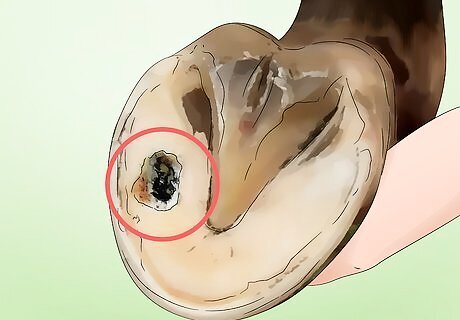
Look for infections or wounds. Once you have cleaned out the hoof, it is important to inspect its health. Look over the surface of the frog and the sole of the hoof for wounds, pus, discharge, or other signs of disease. Any open wounds should be treated so that an infection can be avoided or controlled. In general, treatment includes cleaning out the wound, applying medication to the infection or injury, and keeping the area clean by wrapping it and changing out the wrappings regularly. Look at the surface of the sole. If it is red or bruised this may be a sign that the horse's hooves have been cut too short. Look for black discharge around the frog. This is a sign that your horse has a thrush infection. This is treated by keeping the area clean and dry until the condition clears up. Clear any dirt from the area where the fur meets the hoof wall using a soft-bristled brush. Then, inspect the area for any soft spots or wounds.



















Comments
0 comment